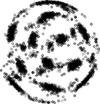You are here: Foswiki>Cosmo Web>CosmoProjects (02 Jul 2010, BoudRoukema)Edit Attach
Cosmology past and ongoing projects in Toruń - brief summary for main page
Shape of the Universe
Scientific models of the Universe are intended to satisfy the Einstein field equations, that roughly speaking, state that curvature = density. The models allow many different sorts of spaces, which have the local property called a metric (a sort of rule for locally measuring distances, that determines curvature) and have global properties that define them, such as topology. Together curvature and topology can be described as shape.Cosmic Topology
TODO boud: brief summary of cosmic topology and our observational and theoretical research program.Metric parameters (curvature)
The metric of our Universe model has many parameters such as the Hubble parameter, the baryon density parameter, the non-baryonic dark matter density parameter, and the dark energy parameter.Fluctuations
The Universe is not perfectly the same everywhere in space - there are fluctuations compared to the average density.Observational constraints - low to high redshift
TODO boud: brief summary of observational large scale structure research programs, e.g. with Gary MamonCMB non-gaussianities, inflationary scenarios
Can a theory of inflation explain the origin of the density fluctuations? There are some observational hints that this might be the case. One of the research strategies for selecting an inflationary theory out of the many available scenarios is to check for non-Gaussian statistical properties of the fluctuations. TODO Bartek: Something about results/projects.Collapsed objects
Density fluctuations on the smaller scales (up to about 1 Mpc) collapsed gravitationally, forming galaxy clusters and galaxies in which stars and planets formed. Comparing observations of galaxies and galaxy clusters to the cosmic microwave background and separating the two effects is a major theme of the observational aspects of the OCRA program using our 32m radio telescope.See also CosmoProjectsOld
| I | Attachment | Action | Size | Date | Who | Comment |
|---|---|---|---|---|---|---|
| |
RBSG08_CCBYSA_GPL_GFDL.jpg | manage | 28 K | 02 Feb 2008 - 16:28 | BoudRoukema | this image is triple licensed CC-BY-SA/GPL/GFDL - choose the one you wish - it is created independently of figures in the article |
| |
RBSG08_CCBYSA_GPL_GFDL_100x105.jpg | manage | 3 K | 02 Feb 2008 - 16:31 | BoudRoukema | this image is triple licensed CC-BY-SA/GPL/GFDL - choose the one you wish - it is created independently of figures in the article |
| |
circle__1.jpg | manage | 39 K | 04 Mar 2008 - 00:34 | BoudRoukema | this image is triple licensed CC-BY-SA/GPL/GFDL - choose the one you wish - it is created independently of figures in the article |
| |
circle__2.jpg | manage | 39 K | 04 Mar 2008 - 00:34 | BoudRoukema | this image is triple licensed CC-BY-SA/GPL/GFDL - choose the one you wish - it is created independently of figures in the article |
| |
circle__3.jpg | manage | 25 K | 04 Mar 2008 - 00:35 | BoudRoukema | this image is triple licensed CC-BY-SA/GPL/GFDL - choose the one you wish - it is created independently of figures in the article |
| |
circle__4.jpg | manage | 24 K | 04 Mar 2008 - 00:35 | BoudRoukema | this image is triple licensed CC-BY-SA/GPL/GFDL - choose the one you wish - it is created independently of figures in the article |
| |
circle__5.jpg | manage | 29 K | 04 Mar 2008 - 00:36 | BoudRoukema | this image is triple licensed CC-BY-SA/GPL/GFDL - choose the one you wish - it is created independently of figures in the article |
| |
circle__6.jpg | manage | 39 K | 04 Mar 2008 - 00:36 | BoudRoukema | this image is triple licensed CC-BY-SA/GPL/GFDL - choose the one you wish - it is created independently of figures in the article |
| |
dodec-aa.ps | manage | 1 MB | 17 May 2004 - 12:55 | BoudRoukema | revised after referee's comments - single-spaced |
| |
isolat-aa.ps | manage | 164 K | 10 Nov 2004 - 15:23 | BoudRoukema | version on astro-ph |
| |
mhg_20050210.ps | manage | 177 K | 10 Feb 2005 - 12:05 | BoudRoukema | Calabretta & Roukema, draft 10 Feb 2005 |
| |
mhg_20050330.ps | manage | 173 K | 30 Mar 2005 - 12:19 | BoudRoukema | Calabretta & Roukema, draft 30 March 2005 |
| |
mhg_20050615.ps | manage | 177 K | 19 Sep 2005 - 11:00 | BoudRoukema | Calabretta & Roukema, draft 15 June 2005 |
Edit | Attach | Print version | History: r32 < r31 < r30 < r29 | Backlinks | View wiki text | More topic actions
Topic revision: r32 - 02 Jul 2010, BoudRoukema
 Copyright © by the contributing authors. All material on this collaboration platform is the property of the contributing authors.
Copyright © by the contributing authors. All material on this collaboration platform is the property of the contributing authors. Ideas, requests, problems regarding Foswiki? Send feedback


